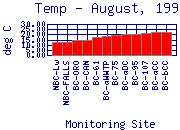 |
|
 |
|
TEMPERATURE
During the warmer months of the year (April to September), water
temperature increases gradually as Boulder Creek moves downstream from the
mountains to the plains (for example, see
August, 1999).  This is primarily a result of regional air temperature
variations. The lowest water temperatures of the North Boulder Creek/Boulder
Creek samples recorded from April to September were at the two sampling points
farthest upstream, North Boulder Creek at Lakewood
Reservoir (NBC-Lw) and North Boulder Creek
Falls (NBC-FALLS).
Warmest temperatures recorded from April to September were at the sampling sites
farthest downstream (Boulder Creek above Coal Creek (BC-aCC) and Boulder Creek below Coal Creek (BC-bCC)). Temperatures at these sites sometimes neared 30°C
(86°F). Exposed to the sun during the long summer days, the water at
the sites on the plains become very warm, especially when flow rates are low and the
water moves slower. The City of Boulder has worked to cool the waters by
planting vegetation (to provide shade) along some areas of lower Boulder
Creek.
This is primarily a result of regional air temperature
variations. The lowest water temperatures of the North Boulder Creek/Boulder
Creek samples recorded from April to September were at the two sampling points
farthest upstream, North Boulder Creek at Lakewood
Reservoir (NBC-Lw) and North Boulder Creek
Falls (NBC-FALLS).
Warmest temperatures recorded from April to September were at the sampling sites
farthest downstream (Boulder Creek above Coal Creek (BC-aCC) and Boulder Creek below Coal Creek (BC-bCC)). Temperatures at these sites sometimes neared 30°C
(86°F). Exposed to the sun during the long summer days, the water at
the sites on the plains become very warm, especially when flow rates are low and the
water moves slower. The City of Boulder has worked to cool the waters by
planting vegetation (to provide shade) along some areas of lower Boulder
Creek.
During the colder months of the year (October to March), water
temperature of Boulder Creek increases gradually from the mountains to just
upstream of the Boulder Wastewater Treatment Plant (WWTP), spikes
significantly at the 75th Street sampling site, and then decreases gradually to
the confluence of Boulder Creek and Coal Creek (for example, see
February, 1999).
 Lowest winter temperatures were observed at the sampling sites in the
mountains (North Boulder Creek at Lakewood Reservoir, North Boulder Creek
Falls, and the Orodell station), where temperatures were often near freezing.
The warmest temperatures in Boulder Creek during winter were observed at 75th
Street. This sampling site is just downstream of where effluent from the WWTP
enters Boulder Creek. Water discharged from the WWTP is warm, because the
waste water entering the plant (coming from our homes and businesses) is
warm. When this water is discharged and mixes with the water in the creek, it
warms Boulder Creek. The water temperature then gradually decreases as
Boulder Creek moves downstream and receives flow from other sources and mixes
with cold air. However, the water does not return to the ambient temperature
of Boulder Creek above the WWTP.
Lowest winter temperatures were observed at the sampling sites in the
mountains (North Boulder Creek at Lakewood Reservoir, North Boulder Creek
Falls, and the Orodell station), where temperatures were often near freezing.
The warmest temperatures in Boulder Creek during winter were observed at 75th
Street. This sampling site is just downstream of where effluent from the WWTP
enters Boulder Creek. Water discharged from the WWTP is warm, because the
waste water entering the plant (coming from our homes and businesses) is
warm. When this water is discharged and mixes with the water in the creek, it
warms Boulder Creek. The water temperature then gradually decreases as
Boulder Creek moves downstream and receives flow from other sources and mixes
with cold air. However, the water does not return to the ambient temperature
of Boulder Creek above the WWTP.

COMPARISON TO REGULATIONS
Colorado Department of Public Health and Environment Water Quality Control Division (CDPHE-WQCD) regulations (5 CCR 1002-31) for temperature depend on how the water body is classified. Upstream of the confluence of South Boulder Creek and Boulder Creek, Boulder Creek is classified as a Class 1 Cold Water stream. Class 1 Cold Water streams should never have temperatures above 20°C (68°F). All of the stream samples upstream of South Boulder Creek were less than 20°C in the period analyzed (1998-2000). Downstream of the confluence of South Boulder Creek and Boulder Creek, Boulder Creek is classified as a Class 1 Warm Water stream. CDPHE-WQCD regulations state that Class 1 Warm Water streams should never have temperatures exceeding 30°C (86°F). No temperatures above 30° C were recorded in lower Boulder Creek in the period analyzed (1998 to 2000).